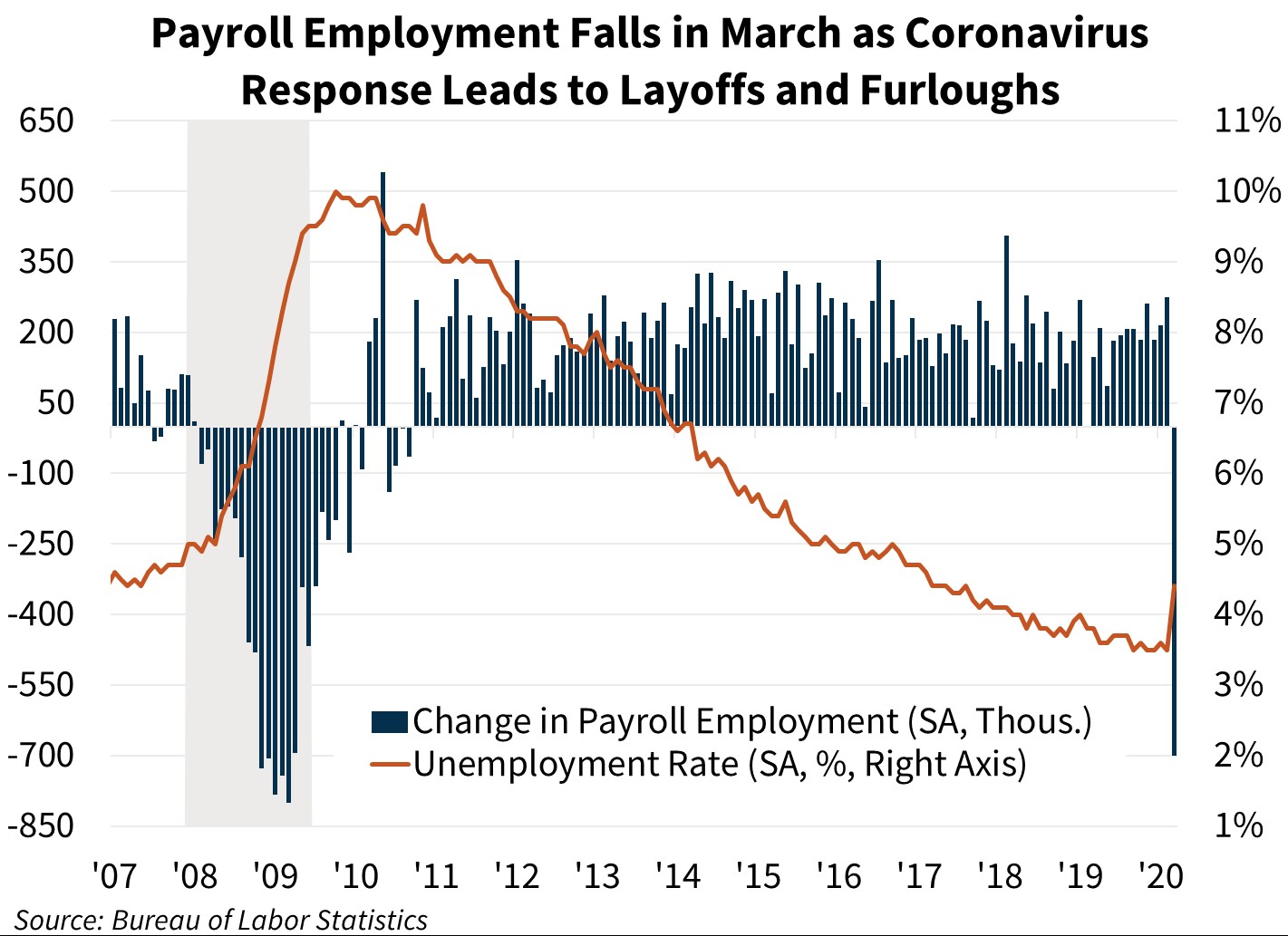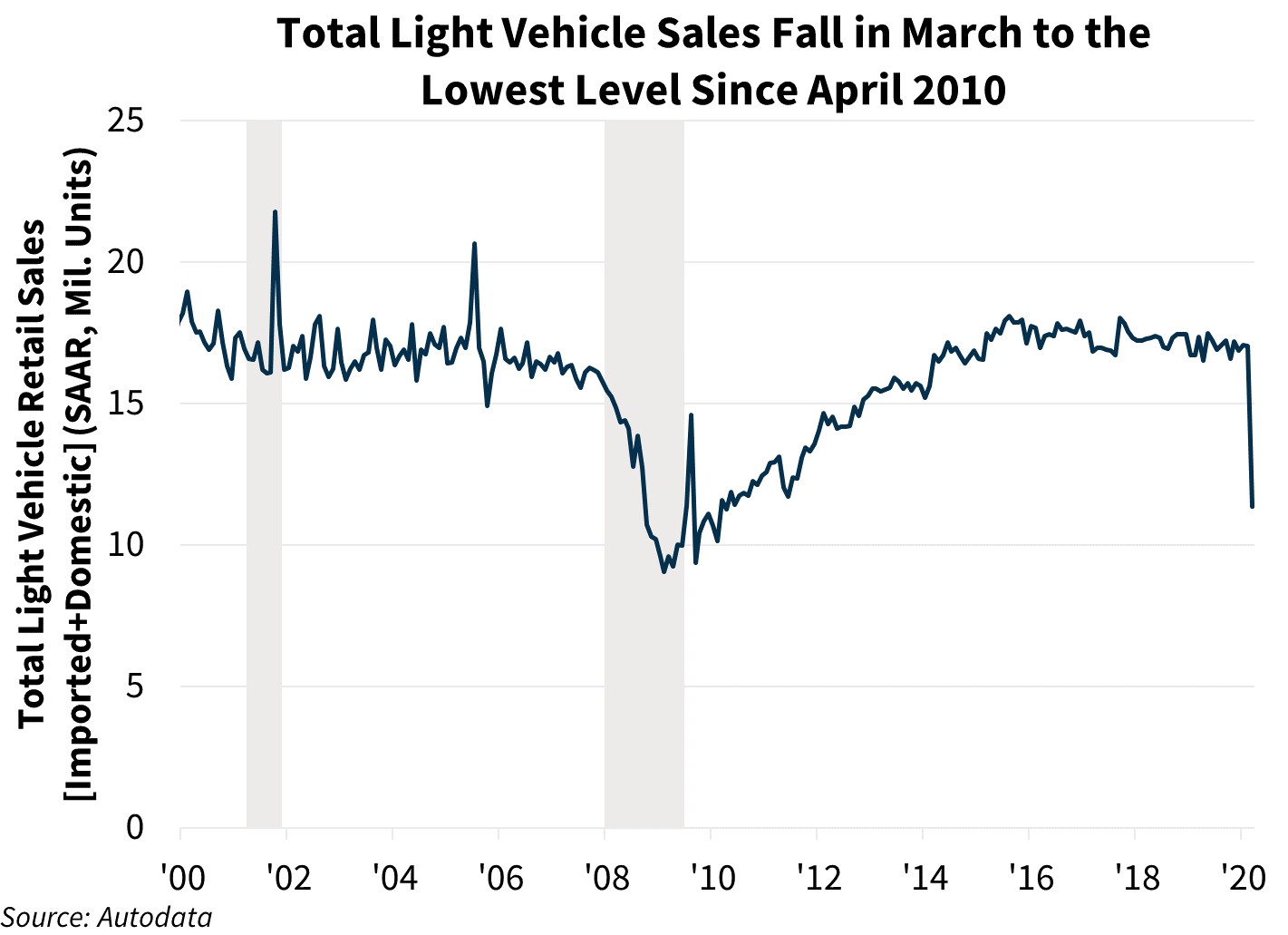Payroll Employment Falls by Most Since 2009, Unemployment Rate Jumps by Largest Amount in 45 Years
Key Takeaways:
- Nonfarm payroll employment fell by 701,000 in March, according to the Bureau of Labor Statistics (BLS), the largest monthly decline in 11 years. The unemployment rate jumped nine-tenths to 4.4 percent, the largest one-month increase in the unemployment rate in 45 years.
- Initial claims for unemployment insurance (UI) surged again, to 6.6 million, in the week ending March 28, according to the Department of Labor, an increase of 3.3 million from the previous week.
- The Conference Board’s Consumer Confidence Index fell 12.6 points to 120.0 in March, the lowest level since mid-2017 and the largest monthly decline since August 2011. The consumer expectations component fell 19.9 points to the lowest level since October 2016, but the decline in current consumer confidence was more modest.
- Light vehicle sales tumbled 33.4 percent in March to 11.35 million annualized units, according to Autodata, the lowest level since April 2010. From a year ago, light vehicle sales fell 34.6 percent, the largest annual decline in nearly 11 years.
- The ISM Manufacturing Index fell one point in March to 49.1, driven by declines in the new orders, production, and employment components. The ISM Nonmanufacturing Index, a gauge of service sector activity, fell 4.8 points in March to 52.5, the largest monthly decline since November 2008. Any reading below 50 indicates contracting activity.
- The real goods trade deficit, an input into the calculation of net exports, narrowed by approximately $9.0 billion to $69.0 billion, the smallest deficit in five years, as exports rose by 2.5 percent and imports fell by 2.3 percent.
- Pending home sales increased 2.4 percent in February to 111.5, the highest level in three years. From a year ago, sales increased 9.4 percent and showed gains in every region.
Forecast Impact
The unprecedented one- and two-week surge in UI claims is greater than any in the history of the series. The additional surge in UI claims is a direct result of the ongoing COVID-19 outbreak, which is severely constraining economic activity and leading to a deteriorating employment situation for an increasingly large portion of the workforce. The recent spike in claims indicates greater financial stress for households in March, which corresponded with a sharp drop in consumer confidence and light vehicle sales, suggesting solidly negative consumer spending in the first quarter. The narrowing of the real goods trade deficit due to a sharp decline in imports suggests that trade could add to growth in the first quarter, particularly as consumer sentiment and demand declines further, which would likely lead to a subsequent decrease in the amount of goods imported.
The March jobs report reflected the first wave of job losses from the ongoing COVID-19 pandemic. As expected, service-providing sectors made up the vast majority of job losses this month, as social distancing measures aimed at avoiding infection severely curtailed demand and kept people home. The data collection period for this month’s jobs report predated the bulk of announced school and business closures, suggesting this report likely fails to capture the true extent of the recent decline in economic activity.
For housing, the increase in pending home sales in February is likely misleading, given that many of these pending sales may have been canceled in the early weeks of March as shutdowns and stay-at-home orders spread across the country. However, it does highlight once again that housing was in a position of strength before the escalation of the coronavirus.


Details on Key Takeaways and Other Releases
- Nonfarm payroll employment fell by 701,000 in March, according to the BLS. The three-month moving average fell to -71,000. The average workweek dropped two-tenths to 34.2 hours, the lowest since January 2011, while average hourly earnings increased 0.4 percent over the month and 3.1 percent from a year ago. The unemployment rate jumped to 4.4 percent, and the BLS stated that it would have been about one-percentage point higher if they had removed instances of non-sampling error. Among unemployed persons, the number who reported being temporarily laid off (who are officially counted as unemployed) more than doubled this month to 1.8 million, and the number of people working part time but who would prefer full time employment increased by 1.2 million. The labor force participation rate for workers 16 years and older fell seven-tenths to 62.7 percent, tying the largest monthly decline since 1968. Manufacturing employment fell by 18,000, while residential construction employment (which includes specialty contractors) declined by 4,300 jobs, ending three straight months of job gains.
- The Conference Board Consumer Confidence Index fell 12.6 points to 120.0 in March. Confidence in consumers’ present situation only fell 1.6 points to 167.7, while the consumer expectations index fell 19.9 points to 88.2.
- Light vehicle sales fell in March to 11.35 million annualized units, according to Autodata. Auto sales fell 34.8 percent to 2.9 million units, the lowest level since the series began in 1980. Light truck sales (which includes sales of SUVs) decreased 32.9 percent to 8.4 million units, the lowest level in six years.
- The ISM Manufacturing Index fell one point in March to 49.1, with the new orders and employment components falling to the lowest level in 11 years. The ISM Nonmanufacturing Index fell 4.8 points in March to 52.5. The business activity component fell 9.8 points to 48.0 and the employment component fell 8.6 points to 47.0, the largest declines since January 2008 and November 2008, respectively.
- The U.S. trade deficit narrowed by $5.6 billion in February to $39.9 billion, according to the Census Bureau, the smallest trade deficit since September 2016. The decline was driven by a 2.5 percent decline in imports, the largest decline since March 2016, as imports from China fell 31.3 percent on an annual basis. Exports fell 0.4 percent. The real goods trade deficit narrowed by approximately $9.0 billion to $69.0 billion.
- The National Association of REALTORS® Pending Home Sales Index, which records contract signings of existing homes and typically leads closings by one to two months, increased 2.4 percent in February to 111.5. Sales rose in every region.
Economic and Strategic Research Group
April 3, 2020
Opinions, analyses, estimates, forecasts and other views of Fannie Mae's Economic and Strategic Research (ESR) Group included in these materials should not be construed as indicating Fannie Mae's business prospects or expected results, are based on a number of assumptions, and are subject to change without notice. How this information affects Fannie Mae will depend on many factors. Although the ESR group bases its opinions, analyses, estimates, forecasts and other views on information it considers reliable, it does not guarantee that the information provided in these materials is accurate, current or suitable for any particular purpose. Changes in the assumptions or the information underlying these views could produce materially different results. The analyses, opinions, estimates, forecasts and other views published by the ESR group represent the views of that group as of the date indicated and do not necessarily represent the views of Fannie Mae or its management.
